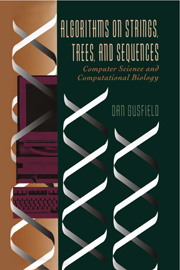I - Exact String Matching: The Fundamental String Problem
Published online by Cambridge University Press: 23 June 2010
Summary
Exact matching: what's the problem?
Given a string P called the pattern and a longer string T called the text, the exact matching problem is to find all occurrences, if any, of pattern P in text T.
For example, if P = aba and T = bbabaxababay then P occurs in T starting at locations 3, 7, and 9. Note that two occurrences of P may overlap, as illustrated by the occurrences of P at locations 7 and 9.
Importance of the exact matching problem
The practical importance of the exact matching problem should be obvious to anyone who uses a computer. The problem arises in widely varying applications, too numerous to even list completely. Some of the more common applications are in word processors; in utilities such as grep on Unix; in textual information retrieval programs such as Medline, Lexis, or Nexis; in library catalog searching programs that have replaced physical card catalogs in most large libraries; in internet browsers and crawlers, which sift through massive amounts of text available on the internet for material containing specific keywords; in internet news readers that can search the articles for topics of interest; in the giant digital libraries that are being planned for the near future; in electronic journals that are already being “published” on-line; in telephone directory assistance; in on-line encyclopedias and other educational CD-ROM applications; in on-line dictionaries and thesauri, especially those with cross-referencing features (the Oxford English Dictionary project has created an electronic on-line version of the OED containing 50 million words); and in numerous specialized databases.
- Type
- Chapter
- Information
- Algorithms on Strings, Trees and SequencesComputer Science and Computational Biology, pp. 1 - 4Publisher: Cambridge University PressPrint publication year: 1997



